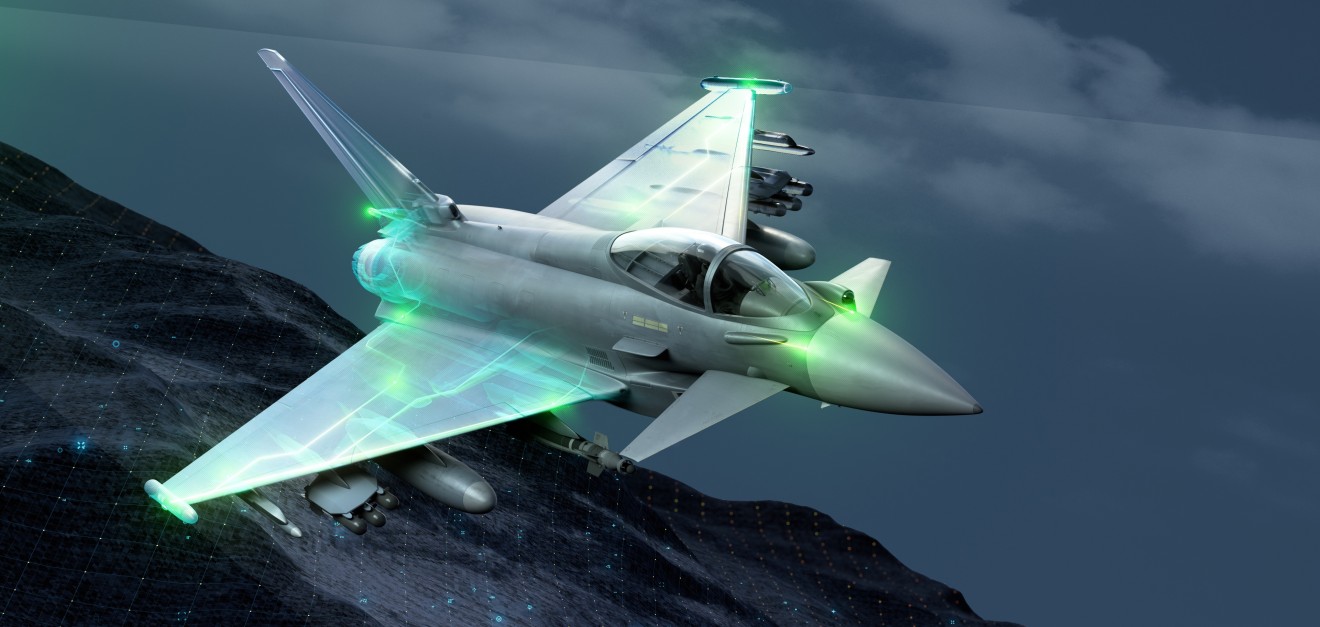
WHAT IS EW?
Electronic Warfare (EW) in the Eurofighter context can be summed up in one phrase: ‘Help them see, keep them safe’. The purpose is to provide information and capability to protect the platform and most importantly, the crew. It is about protecting pilots from anything that's trying to do harm to the platform — most typically missiles.
HOW DOES IT WORK?
Essentially, the Praetorian system helps pilots see by sensing electromagnetic energy in the environment around them that comes from something that could harm them. It listens to radars and laser systems and looks out for missiles approaching the platform.
It gives the pilot ‘situational awareness’, a picture of the environment around them. They are constantly aware of the danger level and where any possible threat is. Then, if they need it the EW system helps keep them safe through deployment of appropriate countermeasures. These are designed to prevent adversary attacks from being successful. They work by either confusing or deceiving the enemy into thinking that you're not there or are somewhere else.
HOW FAR CAN THE PRAETORIAN SYSTEM SEE?
In simple terms, that depends on how much power the adversary system is transmitting. For example, if somebody in your garden has a lighted match, if they're close to you, you see the match. But as they walk away, you get to the point where you can no longer see the match burning because there’s not enough energy getting back to you. The mathematics for the DASS system follows the same principle.
The Eurofighter Typhoon system is sensitive enough to see anything a pilot might be worried about, as far away as they need to see it. It can see up to the limit of the radar horizon which is slightly further than the visual horizon. Effectively the system is designed with the ability to see any weapon system that may attempt to engage the Eurofighter.
A key point here is that with any guided weapon system, the missile’s radar transmits energy to reflect off the target aircraft and track it. This energy bounces back to the radar for it to derive range and angle information to the target. The Typhoon system only has to listen to that energy as it hits the aircraft – a one-way path — and therefore Typhoon can see radars at much greater range than they can see the aircraft. This advantage means that Praetorian can give early warning of missile systems as soon as they start to look at Typhoon, allowing the pilot to avoid or evade the threat.
WHAT DO THE PRAETORIAN SENSORS LOOK FOR?
Electronic Support Measures (ESM) look for radio frequency (RF) energy. Radar-guided weapon systems transmit bursts of RF energy, which have a certain frequency and characteristic in the electromagnetic spectrum.
The ESM systems listen out for this electronic chatter. Each weapon system has a slightly different characteristic. Thanks to Praetorian, Eurofighter is intelligent enough to pick up all the different signals, discriminate them and identify exactly what the threat is.
In addition, Typhoon features a missile approach warner which looks for missiles that are coming towards it at speed. The Italian Typhoon version also features a laser warning receiver which listens for laser signals in a similar manner to the ESM and RF.
HOW DOES THE PRAETORIAN DEFENSIVE AIDS SUB-SYSTEM (DASS) COMPARE TO RIVAL SYSTEMS?
Praetorian is world class in its signal processing and identification capability. But the thing that makes Praetorian stand out is that it has been designed to be completely adaptable – in terms of the way the software is configured and optimised— and this allows users to adapt what it does based on how data is programmed.
Adaptability was a core design aim from the start, and it means the Eurofighter Praetorian system is completely mission programmable.
Each operating nation can decide exactly how they want the system to behave, so for example, can optimise how it searches the environment for threats, or the countermeasures it uses when it detects something.
It also offers operators a rapid turnaround. They can quickly get recorded data off the aircraft, analyse it, and then programme threat data for the next mission, so that the next time they fly the system is updated. That makes Praetorian incredibly powerful because the pilot has the best, most up-to-date information. Not surprisingly, this programmability and adaptability is highly valued by the forces that use it.
WHAT DO WE MEAN BY EUROFIGHTER’S DIGITAL STEALTH?
With countermeasures you are either trying to ‘disappear’ or persuade the threat that's looking at you that he really wants to look some other way. Praetorian can do both or combinations of each — it’s a form of what’s been dubbed ‘digital stealth’.
Of course, no aircraft can be invisible, but you can make yourself very small and hard to find. Some aircraft do it by their shape or their skin, known as “stealth”, Eurofighter does this digitally. Praetorian transmits waveforms that make it harder for an adversary to find it. For instance, it can increase the background noise that the radar must overcome, and then hide in this digital smokescreen. In physics terms that’s the equivalent of making yourself a much smaller target.
The system can also transmit waveforms to make the enemy think there is a better target elsewhere. In its countermeasures arsenal, Eurofighter has a towed radar decoy, a jammer on a cable that is towed behind the aircraft, to deceive rival radar, which adds a geographical aspect to the fight against threats. The beauty of using digital stealth is that it can adapt to any changes in the threat, without having to make any design changes to the aircraft shape or covering.
WHAT BENEFIT WILL EW BRING TO THE E-SCAN RADAR Mk2?
A radar with an EW component is relatively unusual but the UK has committed to a significant development programme to enhance the EW capabilities of the Eurofighter’s new ESCAN radar, through the Mk2 programme. The concept is that you already have a high-quality, high-power radar on the aircraft. In a strike attack, it's the radar that will pinpoint the target. In a conventional set-up when the EW system is in the sensing mode, it gives the pilot a picture of the environment — it's like a road map pointing you to the street location of your “target”.
The pilot can then use the radar to pinpoint exactly where that target is. The ESM gives the first part of the picture, the radar then confirms it and can guide missiles. But the point about the ECRS Mk2 radar is that Eurofighter pilots will be able to use the radar antenna to transmit jamming wave forms to make it even harder to engage the aircraft. That gives the programmers an extra dimension — they can push out wave forms through the radar, steer them to the threat and combine that with the existing countermeasure suite, giving significantly more options in the future.
